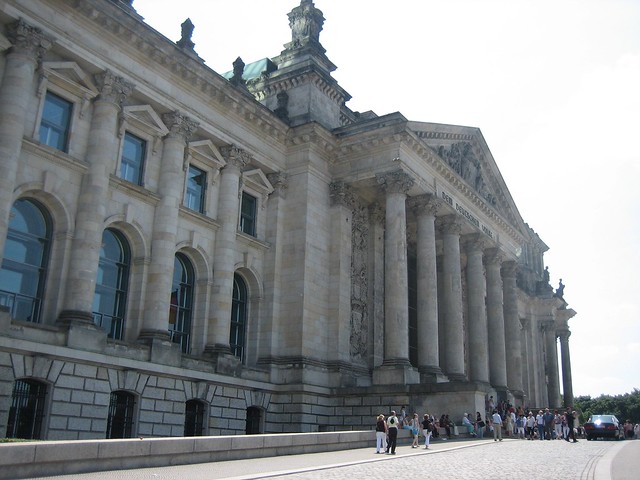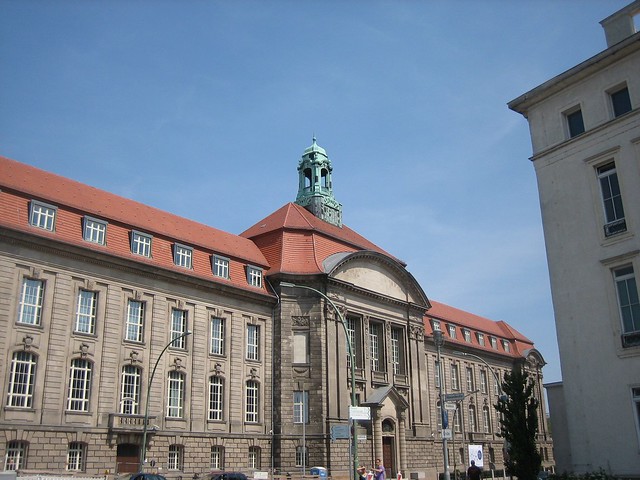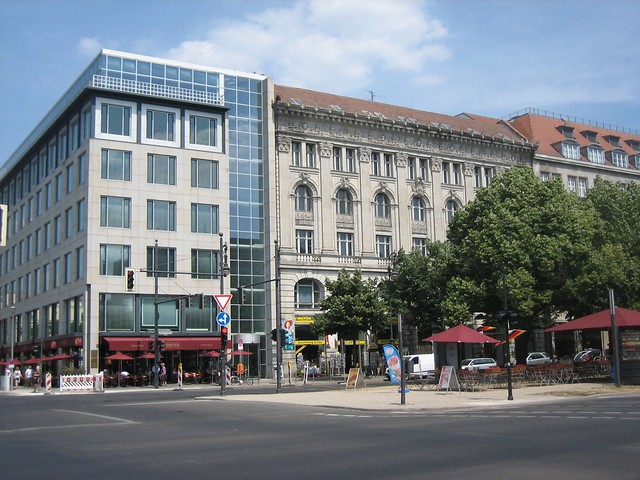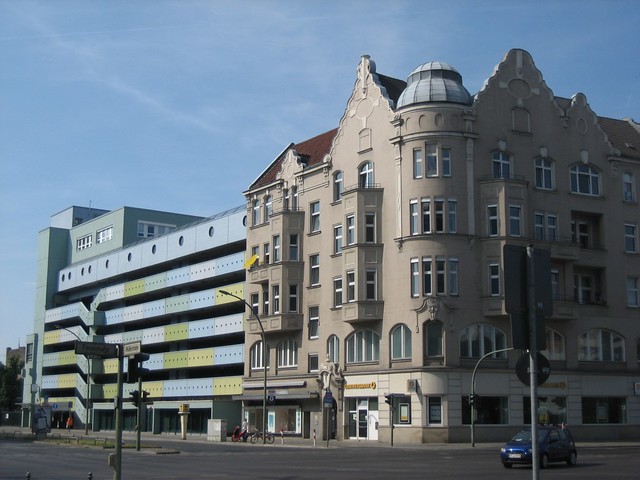If you know French, you may be assuming that I was being a lazy bum in Berlin. If you're up on your Baudelaire, you might wonder if I was walking a turtle on a leash through the red light district. That's not exactly right either, but I really like walking through the streets of a city, seeing the architecture, the traffic, the shops, and the people - not walking just to get somewhere, but for the sake of being in the middle of things.
Berlin is a fantastic city for walking around. It's on flat terrain, has wide sidewalks, sane traffic, and a vibrant but generally safe street life. We stayed in an apartment near Wedding, about an hour's walk northwest of the Brandenburg Gate, and usually walked to and from downtown, trying to take a different route every time.
Here are some random thoughts from several days walking the streets of Berlin.
Places like London, Istanbul, and Rome had led me to assume that European cities are dense urban mazes, their huge populations crammed into every available space, and cursed with crazy traffic and crazier intersections - only in newer countries like the USA or Canada, I thought, were cities new enough and the countryside unsettled enough for there to be enough space to spread out. Well, I was wrong. Berlin is a city on a broad scale, with wide boulevards and large buildings and a lot of open space. Much of the city was built in the 19th century with the idea that it would be an imperial capital, and it seems to have taken many of the urban planning lessons of the Enlightenment and the example of Haussmann's Paris to heart. The boulevards are wide and the blocks are long and the buildings tend towards the majestic - at times in that supersized if-only-the-Romans-had-known-about-steel-reinforcement classicism you can also find a lot of in other capitals like Vienna and Washington D.C..
I was at first overwhelmed by the scale of the buildings in Berlin - something I had not expected, since I'm used to large-scale North American construction in places like Toronto, Chicago, and New York. It took me a while, but I eventually figured out what it was: while I'm used to massive vertical scale in a dense urban environment, I'm not used to horizontal scale. Berlin doesn't have a lot of 50-story skyscrapers, but it has many buildings with similar amounts of floor space but in six stories and spread along an entire large city block. Imagine a suburban corporate headquarters building, such as the IBM complex in Markham, or the Apple's One Infinite Loop, and imagine a large stone classical building like Buckingham Palace - and then imagine an entire city of these kinds of buildings all built next to each other, right to the sidewalk. I later realized that the mass of these buildings is a bit deceptive: they're usually built around interior courtyards, while my North American assumption is that buildings fill in their entire frontage.
For all its massive scale, Berlin is bicycle and pedestrian friendly in a way that makes a long-time Torontonian extremely jealous. The transit system is also fantastic - actually, let me be more accurate: the transit systems are fantastic, all three of them. Tickets last a certain amount of time, and you can do as much transit as you'd like within that time. Also instead of turnstiles and lots of security, they work on the honour system, running frequent spot checks on the trains themselves. Almost every sidewalk has a red-paved bicycle lane on it, and people bicycle everywhere. It of course helps that Berlin is a mostly flat city. Also I think it has a lot to do with the fact that the car has never been the default transportation mode here, especially in the eras when the city was being built or re-built. The wide roads certainly have automobile traffic, but I never saw much heavy traffic or gridlock when I was there - although it's possible I just wasn't in the right parts of town.
Unlike in Toronto, the bicyclists in Berlin are generally courteous, happy and friendly - most of them don't even wear helmets! I think this has a lot to do with the fact that they're not risking their lives and dodging car traffic all the time.
The city feels a bit empty. I thought this might just be a contrast with the non-stop bustle of Istanbul, but it turns out that the population of Berlin is actually shrinking slightly, and so the city is a little overbuilt. It's still a city of 4 million people and a major world capital, but it had more people living there in the 1930s and the 1990s. There are still large empty lots here and there in otherwise bustling parts of the city, where there just doesn't seem to be enough demand to do anything with them.
One of the great things about walking through Berlin is the different design approaches different buildings take. Shiny glass and steel, Art Deco, brightly-coloured soviet concrete, baroque, and mock-medieval - you can see all of these in a single city block.
When we left Istanbul, we were a bit sad that we wouldn't be seeing any Apple Tea or Kebab any more - but we ended up staying in a mixed Turkish neighbourhood near Leopoldplatz, so as we got out of the subway we saw Turkish grocery stores and kebab stands and women in headscarves, just like we had left behind a few hours earlier.
Berliners, especially the younger ones, seem to be in remarkably good shape, especially considering what their food is like - I guess all the walking and biking around makes up for it.
Someone - I think it was Richard Florida - recently said that big cities have more in common with other big cities around the world than with their surrounding countries. I certainly felt this way in Berlin. I felt like I fit right into the pace of things there, even if I didn't really speak the language.
You can dress up however the hell you want in Berlin - and people do. I saw goths, transvestites, guys playing bagpipes, tattooed bikers, bearded hipsters, lotharios, Muslim women wearing the hijab, round-glasses intellectuals, drunken football fans wearing only a German flag - and nobody seemed to really care one way or another. I bought a hat in Berlin (they were hit pretty hard by this summer's heat wave - multiple days of 35+ degrees and intense sun) and I've never been much of a hat person, so I was at first kind of nervous about wearing it, but then saw repeated reminders that nobody cares what you wear in Berlin.
A little thing that made a big impression: it seems you can walk around the city with an open bottle of beer in your hands - you even take it on public transit. Of course, the only people who you see doing this are exactly the kinds you would expect: party-hearty young guys or older vagrant types. I gather that beer isn't considered a particularly dangerous drink here. The walkabout beverage of choice seemed to be the inexpensive (1 euro for 500ml) but quite tasty (Reinheitsgebot) Berliner Bier. I'd see these people wandering the streets with beers in their hands and think 'wow, what a poor lush, to be out drinking in the streets like that' - but then realize that I had just had a pint for lunch myself, the only difference being I was sitting at a table at the time.
I later discovered people drinking beer in the streets in Edinburgh - so maybe it's a Europe-wide thing - but only in Berlin did I see the BierBike!
(More photos of Berlin can be found my flickr set.)




